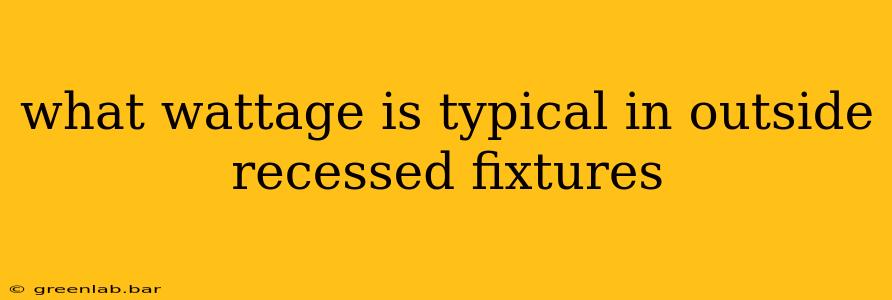Choosing the right wattage for your outdoor recessed lighting fixtures is crucial for achieving the desired illumination level and ensuring longevity. The wattage used in outdoor recessed fixtures varies significantly depending on several factors, and there isn't one single "typical" wattage. This guide will delve into the specifics to help you make an informed decision.
Factors Affecting Wattage Choice
Several key factors influence the appropriate wattage for your outdoor recessed lights:
-
Fixture Size and Design: Larger fixtures generally accommodate higher wattage bulbs, offering greater light output. The fixture's design also plays a role; some are better suited to handling the heat generated by higher-wattage bulbs. Always check the manufacturer's specifications for maximum wattage recommendations.
-
Bulb Type: The type of bulb significantly impacts wattage and light output. LED bulbs, for instance, offer significantly higher lumen output (brightness) at lower wattages compared to incandescent or halogen bulbs. A 10-watt LED bulb can often produce the same amount of light as a 60-watt incandescent bulb.
-
Application and Desired Light Level: The purpose of the lighting dictates the required wattage. Pathway lighting might require lower wattage for soft ambient illumination, while security lighting demands higher wattage for brighter, more focused illumination. Consider the area you're lighting and the desired ambiance.
-
Distance from the Surface: The distance between the fixture and the surface being illuminated influences the required wattage. Further distances require higher wattages to achieve adequate illumination.
Common Wattage Ranges for Outdoor Recessed Fixtures
While a single "typical" wattage doesn't exist, here's a breakdown of common wattage ranges for different bulb types and applications:
LED Bulbs:
-
Low-Wattage (5-10W): Ideal for subtle accent lighting or pathway lighting where a soft glow is desired. These are energy-efficient and long-lasting.
-
Medium-Wattage (10-20W): Suitable for general purpose outdoor lighting, providing adequate brightness for patios, decks, or walkways.
-
High-Wattage (20W+): Best for security lighting or areas requiring bright illumination. These may require fixtures designed for higher heat dissipation.
Incandescent/Halogen Bulbs (Less Common Now):
Due to their inefficiency and heat generation, incandescent and halogen bulbs are becoming less prevalent in outdoor recessed fixtures. However, if you encounter them, wattage ranges are typically higher than LED equivalents to achieve similar brightness levels. Always check the fixture's maximum wattage rating.
Important Note: Always check the manufacturer's specifications for both the fixture and the bulb before installation. Using a bulb with a wattage exceeding the fixture's rating can lead to overheating, fire hazards, and damage to the fixture.
Choosing the Right Wattage: A Step-by-Step Guide
-
Determine the Purpose: What is the intended use of the outdoor lighting? (e.g., pathway lighting, security lighting, accent lighting)
-
Select the Bulb Type: LEDs are the most energy-efficient and long-lasting option for outdoor applications.
-
Check Fixture Specifications: Consult the manufacturer's instructions for maximum wattage and bulb compatibility.
-
Consider the Area and Distance: Evaluate the area to be illuminated and the distance from the fixture.
-
Choose the Appropriate Wattage: Select a wattage that balances energy efficiency, brightness, and fixture safety.
By carefully considering these factors, you can select the appropriate wattage for your outdoor recessed lighting fixtures, ensuring both functionality and safety. Remember, consulting a qualified electrician is always recommended for complex installations or if you're unsure about any aspect of the process.

